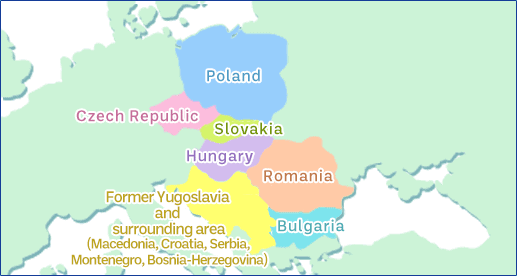
Yogurt in Eastern Europe
Former Yugoslavia and surrounding area / Czech Republic and Slovakia / Hungary / Bulgaria / Poland / Romania

Former Yugoslavia and surrounding area (Macedonia, Croatia, Serbia, Montenegro, Bosnia-Herzegovina)
In the former territories of Yugoslavia, plain yogurt is called “kiselo mleko” while it is called “kisela vrhnja” in Bosnia-Herzegovina and Croatia. In these regions, people also make a condensed and fermented milk product called “ジムネ” which is prepared in October and November of each year, by pouring sterilized and cooled sheep milk into wooden buckets, mixing in starter cultures, letting it ferment for one day, and then adding more sterilized milk to the blend the next day and letting it ferment for another week, after which the whey is removed. Other variants of yogurt seen in the regions include gruzovina, which is a cultured dairy product traditionally produced in the mountain areas using mesophilic lactic acid bacteria; basa, which is a condensed fermented milk typically produced in the mountain villages of Croatia; and “スコループ,” which is widely consumed in Bosnia-Herzegovina, Serbia and Montenegro and is prepared by fermenting brined milk.
Czech Republic and Slovakia
These countries also have long histories of pastoralism and dairy-making. In terms of fermented milk products that are prepared with butter starters, there is alma, which consists of 12% non-fat milk solids, 6% fat, and 6% protein and is a blend of condensed sour milk and rennet; milk kefir, which is prepared through fermentation using kefir starters; sour zincica, which is a kefir-like beverage made by fermenting whey that is a byproduct of the process of making bryndza cheese.トバロー, which is a condensed cultured dairy product made by removing whey from fermented milk.
Hungary
Yogurt is called “tarho” in Hungary, and this word has apparently been used since the 14th century. Other variants of yogurt unique to the country include サス・ティ, which is a traditional condensed fermented milk that is prepared by adding rennet to sheep milk, fermenting the mixture with lactic acid bacteria, and removing whey afterwards, and urda, which is a cultured dairy product that is made by fermenting whey with lactic acid bacteria and yeasts.
Bulgaria
There are various traditional fermented milk products in Bulgaria as follows.
Kiselo mlyako:
This yogurt, made from sheep, cow, and buffalo milk, is an essential part of Bulgarian people’s staple diet. It is fermented with Lactobacillus delbrueckii subsp. bulgaricus and Streptococcus thermophilus, both of which are considered thermophilic (cultured in the temperature range between 37 and 45℃).
Bulgarian milk:
This is a fermented milk known for its very sour taste, which is prepared by boiling and then cooling sheep or cow milk, and fermenting it with L. bulgaricus at 40 to 45℃.
Brano mlyako:
This is a fermented milk that has been traditionally consumed in the mountain regions as a source of protein during winter. It is prepared by heating and then cooling sheep milk, mixing in starter cultures, and fermenting at 15 to 20℃, while adding boiled and cooled sheep milk every day for 25 to 30 days. When the fermentation is complete, sunflower oil, butter oil, or melted kashkaval cheese is put over the surface of the fermented milk for storage. This fermented milk is prepared in September and October each year.
ウルグトニック:
This fermented sheep milk product is similar to yogurt, and is traditionally made and consumed in the mountain regions of the Balkans.
Poland
Poland is one of the Eastern European countries where pastoralism and dairy-making are actively practiced. Kefir and various other cultured dairy products that are fermented with butter starters are made in large quantities in Poland. Another cultured milk product widely consumed is lyntyca, which is a kefir-like beverage made by fermenting whey that is a byproduct of the process of making bryndza cheese. Twarog, which is a condensed cultured dairy product made by removing whey from fermented milk.
Romania
The variations of yogurt that are widely consumed in Romania include cultured dairy products fermented with butter starters, kefir, and acidophilus milk. The condensed fermented milk that is traditionally made in the country is called oxygala.



















